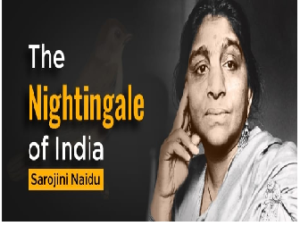Indian Weavers
-Sarojini Naidu (1879-1949)

About the Poet:
Sarojini Naidu was born in a Bengali family in Hyderabad in 1879 and died in 1949. She was a political activist, feminist and the poet. Even she was the first Indian woman who became the President of the Indian National Congress. She was an important figure in India’s Struggle for Independence. She was called as the Nightingale of India. Later she became the Governor of the United Provinces (today’s Uttar Pradesh) in 1947 becoming the first woman to hold the office of the Governor in Independent India.
She began writing at the age of 12. Her first book was published in 1905, titled The Golden Threshold. She has used rich sensory images in her writing. She had mostly written lyrical poems. Her poems are a reflection of her love for nature and her observation of the world around her life.
About the Poem:
It is a short poem consisted of three stanzas. In each stanza the speaker of the poem asks a question to the Indian weavers and gets answer to his question. This poem explores the three main stages of human life-birth (childhood), adulthood (young) and death (old). Poet cast the light on the three types of garments which are being woven at three different times of a day. The colours mentioned in the stanzas are very significant as they indicate the moods related to the events.
Summary:
The poem is about the three important stages of human life- birth, youth and death. These stages are represented using the three different types of garments that the Weavers view at 3 different times of the day. Different colours are also used in all the stanzas of the poem. These colours are having symbolical meaning in it.
Weavers, weaving at break of day,
Why do you weave a garment so gay?……
Blue as the wing of a halcyon wild,
We weave the robes of a new-born child
In the first stanza, the poet asks the weavers why they are weaving very happily a garment so early in the morning. The weavers reply that they are weaving the garment for a newborn child. And the colour of the garment, the Robes is bright blue colour as like the wings of the wild Halcyon. While weaving the garment Indian viewers are so happy.
Weavers, weaving at fall of night,
Why do you weave a garment so bright?……..
Like the plumes of a peacock, purple and green,
We weave the marriage-veils of a queen.
In the second stanza again the poet asks one more question to the Indian weavers why they are weaving a bright coloured garment in the evening. To this question, Indian weavers reply that they are weaving the marriage veils for a queen and the colour of this garment is purple and green which is like the feathers of a peacock. This stanza highlights the second stage of human life which is very important and filled up with ups and downs and with challenges.
Weavers, weaving solemn and still,
What do you weave in the moonlight chill……
White as a feather and white as a cloud,
We weave a dead man’s funeral shroud.
In the last stanza the mood of Indian weavers is changed. Now they are very solemn, very silent. As the poet asks them why they are weaving in the chilly moonlight answer which is the last event of human life they answer that they are weaving a garment which will be used to rap the dead body. It is the last stage of human life. The color of that garment is white as like a feather and a cloud. The white color symbolizes death.

One Reply to “Indian Weavers Poem Summary 12th HSC”